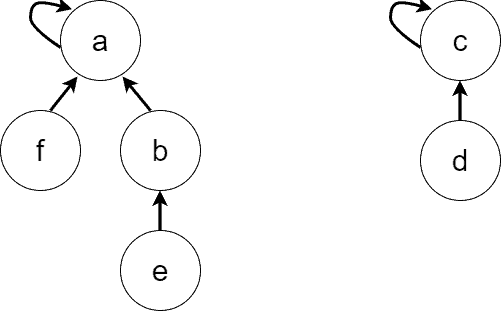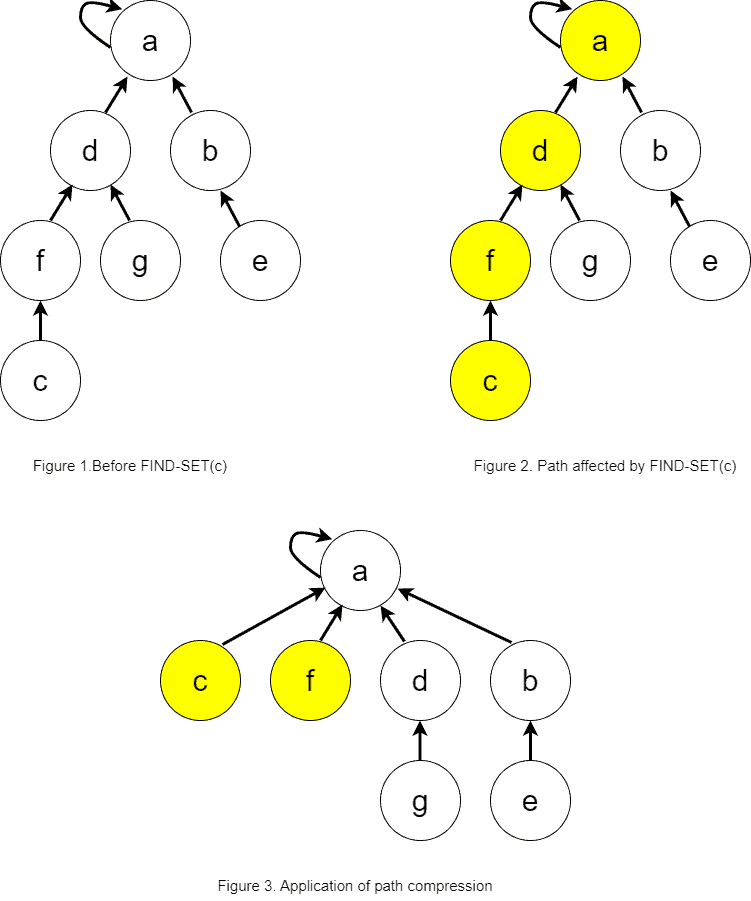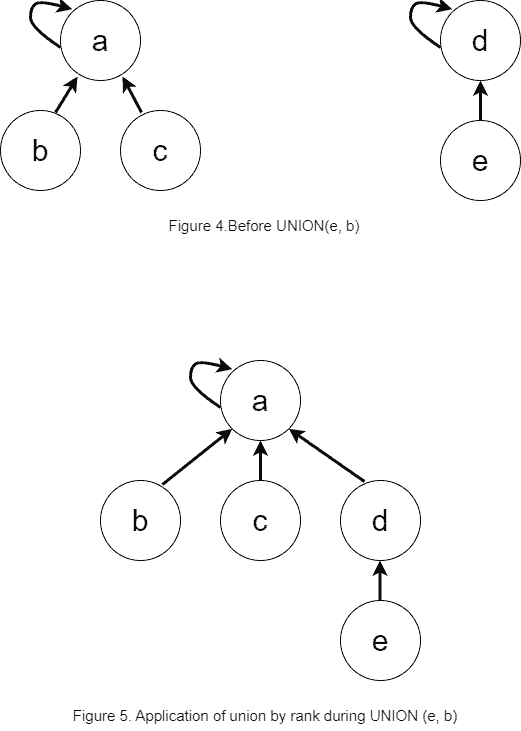Learn through the super-clean Baeldung Pro experience:
>> Membership and Baeldung Pro.
No ads, dark-mode and 6 months free of IntelliJ Idea Ultimate to start with.
Last updated: March 18, 2024
In this tutorial, we’ll cover the Disjoint Set Union (DSU) data structure, which is also called the Union-Find data structure. Initially, we have a universe of
elements:
, and we’re interested in separating elements into independent (non-intersecting) sets. Additionally, we must support the union operation of two sets. Lastly, for any given element, we must be able to find the set it belongs to.
Usually, the applications that use DSU are interested in two types of queries:
To support such queries, DSU defines the following operations:
Let’s understand how the two types of queries can be answered by supporting the defined operations. is called initially for each element of the universe to put in its own set. When we’re trying to decide if two elements are in the same set for the check query, we perform
and
, and if the returned values match, then they’re in the same set. The union query is covered by simply performing the
operation.
The efficiency of operations supported by DSU depends on the structure we select for representing the sets. There are several representations, but the most efficient is the forest of trees. In the representation, each independent set is a rooted tree, and all the trees together form the forest. In each set, we designate the representative of the set, which can generally be any element of the set. Still, in the forest representation, the representative of the set is the root element of the tree.
Additionally, a tree node contains a set element and a link to the parent node. The parent of the root node is the root itself. Following this idea, the representative of a set can be found by following the parent links up the tree, starting from any node until we get to the root node.
Let’s walk over the process of forest construction. Assume we have a universe that will be used to construct DSU as a forest of trees. Originally, we put each element in its own independent set, thus, initially, we get six trees in the forest by performing six operations
:

Now, any returns
. Let’s unite some of the sets. First, let’s perform
and
. The resulting forest is:

Now, and
belong to the same set, and
is the representative of that set, so
. Similarly,
. Second, let’s perform
, and then
. We get the forest:

The Naive versions of the operations implement the ideas discussed so far. simply creates a tree with a single node for the element
, and the parent link of the node points to itself. For clarity, we’d need an auxiliary operation
, which creates the initial node of a tree:
algorithm CREATE_NODE(a):
// INPUT
// a = an element
// OUTPUT
// A = a node containing a as the value and pointing to itself
A <- new node
A.parent <- A
A.value <- a
return AThe pseudocode for is as simple as:
algorithm MAKE_SET(a):
// INPUT
// a = an element
// OUTPUT
// The tree containing only the root node with a as its value
return CreateNode(a) returns the node with the representative element of the set to which the element
belongs. To achieve that, we start from the node containing the element
and follow the parent links until we find a node
for which
:
algorithm FIND_SET(A):
// INPUT
// A = the node containing the element a
// OUTPUT
// R = the node which is the root of A's tree
while A != A.parent:
A <- A.parent
return A appends the root of the
tree to the root of the
tree:
algorithm UNION(A, B):
// INPUT
// A = the node containing the element a
// B = the node containing the element b
// OUTPUT
// The trees containing A and B are united and the root node of the resulting tree is returned
if A != B:
B.parent <- A
return A is a constant operation as it creates a tree node and puts the set element
into the created root node.
is a linear operation. Indeed, its complexity depends on the height of the tree to which
belongs, and we can come up with a sequence of
operations which build a long linear tree. Thus, the naive
is an
operation, where
is the size of the universe
.
is also an
operation as it relies on
to perform its duty, and besides that it performs
work by reassigning the parent link of the
tree.
As we see, the bottleneck operation holding DSU back from being a constant time data structure is . Thus, let’s see what optimizations we can perform to make the operation faster.
The first idea is to shorten the tree height during the operation. To do that, we change the parents of all the nodes on the path from
node to the root node. How? We make all the parents point directly to the root node. The action has the effect of converting a deep tree into a flat tree. Let’s see an example:

In ‘Figure 1’, we can see the tree prior to performing operation. ‘Figure 2’ marks the path affected by
. Finally, ‘Figure 3’ shows the effect of the path compression heuristics and the marked nodes are the ones which paths have been shortened.
The pseudocode of takes the form:
algorithm FIND_SET(A):
// INPUT
// A = the node containing the element a
// OUTPUT
// R = the node which is the root of A's tree
if A != A.parent:
A.parent <- FIND_SET(A.parent)
return AOf course, we could implement iteratively, but the recursive version is shorter and more readable.
The second optimization occurs during the operation. While in the naive implementation of
we simply hang the
tree on the root of the
tree, now we’ll be more selective and won’t allow tree heights to grow fast.
To have a criterion for deciding how to unite two trees, we define the notion of the tree rank. We may define the rank of a tree to be the size of the tree (the number of nodes), though some references define the rank to be the upper bound of the tree’s height. Regardless of the rank selection approach, we hang the tree with the smaller rank to the root of the tree with the bigger rank. When the ranks are equal, we can select the tree to be hung arbitrarily. Also, let’s pay attention to the fact that path compression doesn’t change tree ranks regardless of the rank selection approach.
For our discussion, let’s choose the tree-size approach for the rank. The example below demonstrates the union by rank heuristics:

The rank of the left tree in ‘Figure 4’ is three, while the rank of the right tree is two. Thus, we hang the right tree on the root of the left tree. We can see the result of the operation in ‘Figure 5’.
The pseudocode of with union by rank takes the form:
algorithm UNION(A, B):
// INPUT
// A = the node containing the element a
// B = the node containing the element b
// OUTPUT
// The trees containing A and B are united, and the root node of the resulting tree is returned
A <- FIND_SET(A)
B <- FIND_SET(B)
if A = B:
return A
newRank <- A.rank + B.rank
if A.rank >= B.rank:
B.parent <- A
A.rank <- newRank
return A
else:
A.parent <- B
B.rank <- newRank
return BThough the union by rank heuristics is performed in the operation, it speeds up
.
is optimized indirectly as it depends on
.
The modified operations with the optimizations applied are estimated using the amortized analysis. We’ll only provide the results of optimizations without digging into the details of complexity analysis as it’s vast and complex.
It turns out that each optimization separately speeds up the operations. But when the two optimizations are applied together, they make the DSU operations run in time, where
is the inverse Ackermann function.
is a very slowly growing function and for any possible practical value of
,
. Thus, practically all the DSU operations run in constant time on average.
A detailed analysis of the complexity can be found in chapter 21.4 of the book “Introduction to Algorithms, third edition” by Thomas H. Cormen et al.
There are some practical applications of DSU in graph problems. Let’s denote an undirected graph by , the graph vertices by
, and the graph edges by
. We’ll assume the graph has
vertices and
edges.
The problem of finding the connected components appear in various applications. For example, imagine a black-and-white picture where we want to count the number of black regions. The pixels of the image can be treated as vertices of the graph, and two adjacent pixels are connected with the edge if they have the same color. We can solve the problem using DSU.
The algorithm of finding the connected components is simple: initialize DSU with . Then, iterate over the edges of the graph and unite the sets of the two vertices of each edge. In the end, each set represents a connected component:
algorithm FindingConnectedComponentsUsingDSU(G):
// INPUT
// G = a graph
// OUTPUT
// The connected components in the form of DSU sets
for v in G.V:
MAKE-SET(v)
for e in G.E:
UNION(e.v1, e.v2)Additionally, we might need to perform a linear scan over the vertices of the graph to see which connected component each vertex belongs to. The algorithm complexity is .
The problem of finding the connected components can also be solved using DFS or BFS algorithms which have the same complexity (though they are easier to implement). DSU wins over DFS or BFS for solving the problem when there’s an additional condition to preserve the connected components’ information while adding new edges to the graph.
Another popular usage of DSU is in the Kruskal’s algorithm for finding the minimum spanning tree of an undirected graph. The straightforward implementation of Kruskal’s algorithm runs in time. DSU improves the asymptotic to be
.
In Kruskal’s algorithm, we first sort the edges by their weights in increasing order. Then, we iterate over the sorted edges in increasing order of weights, and we unite the sets of each edge’s vertices if they are in different sets (connected components). In a connected undirected graph, there can be a maximum of union operations, after which we get the minimum spanning tree:
algorithm KruskalsAlgorithm(G):
// INPUT
// G = a graph
// OUTPUT
// MST = the minimum spanning tree as a set of edges
Sort G.E in ascending order of weights
for v in G.V:
MAKE-SET(v)
MST <- an empty set
for e in G.E:
V1 <- FIND-SET(e.v1)
V2 <- FIND-SET(e.v2)
if V1 != V2:
Add e to MST
UNION(e.v1, e.v2)
return MSTIn this article, we introduced the DSU data structure, defined its operations, and described the best representation of DSU as a forest of trees. Then we demonstrated ways to optimize the operations to create a near-constant time data structure. Additionally, we showed some of the applications of DSU in graph problems.